Active from 1900 | Genres Classical, World | |
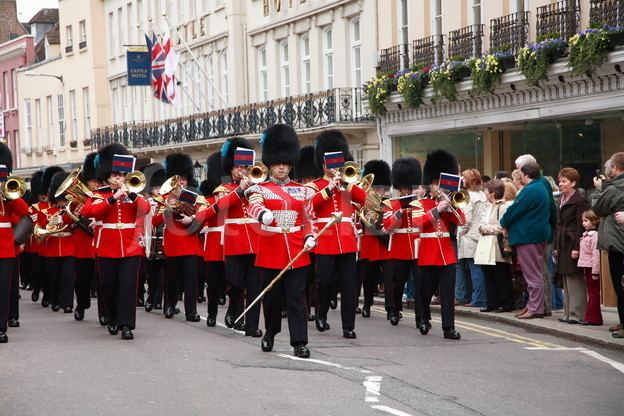 | ||
Also known as Band of HM Irish Guards Website Band of the Irish Guards - British Army Albums Marching With the Beatles Record labels K-tel, Columbia Graphophone Company Similar Band of the Welsh Guards, Band of the Grenadier Guards, Band of the Scots Guards, Band of the Coldstream Guards, Corps of Army Music Profiles | ||
Band of the irish guards
The Band of the Irish Guards is one of five bands in the Foot Guards Regiments in the Household Division whose main role is to guard the British monarch. The Band supports the Regiment by providing the musical backing to which much of the ceremonial duties depend within Central London.
Contents
- Band of the irish guards
- The band of the irish guards changing the guard at windsor castle 22 april 2016
- Regimental marches
- History
- Drums and Pipes
- Corps of Drums
- Key personnel
- Directors of Music
- Pipe majors
- Drum majors
- Ensembles
- Events
- Songs
- References
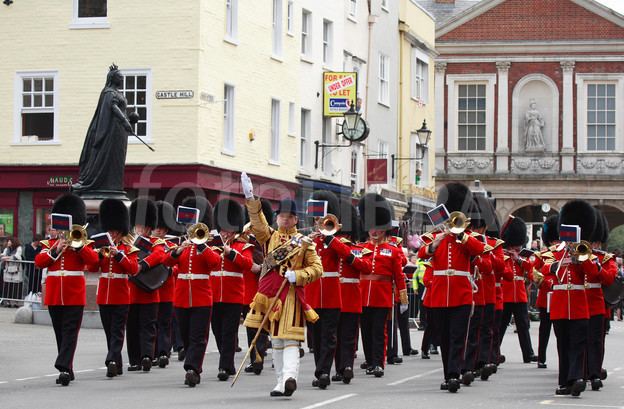
Unlike the 1st Battalion, Irish Guards, which moves to various duty stations around the world, the Band is based permanently at Wellington Barracks in St James's, London.
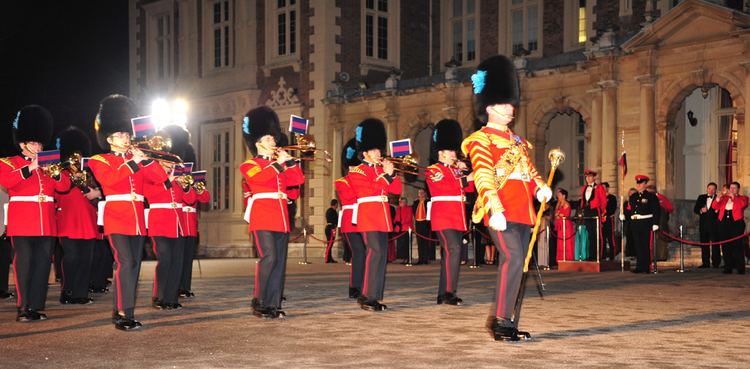
The band of the irish guards changing the guard at windsor castle 22 april 2016
Regimental marches
The Regimental Quick March is St Patrick's Day, The Regimental Slow March is Let Erin Remember
History
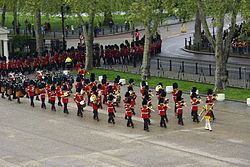
The Irish Guards was formed on 1 April 1900 to commemorate the bravery of the many Irish regiments which fought in the South African campaigns. Under the direction of its first Bandmaster, Warrant Officer Charles Hassell, the Regimental Band made its first public appearance the following year. The Band quickly gained a reputation for excellence as evidenced by the glowing press reports in 1905 for what turned out to be the first of many tours of Canada. The citizens of Toronto were so impressed with its performance that they presented the Band with an ornate silver cup, which remains one of its cherished possessions to this day.
On 23 January 1923, the Band made what is believed to be the very first broadcast by a military band, the programme being broadcast live on the 2LO station from a studio in Marconi House in The Strand.
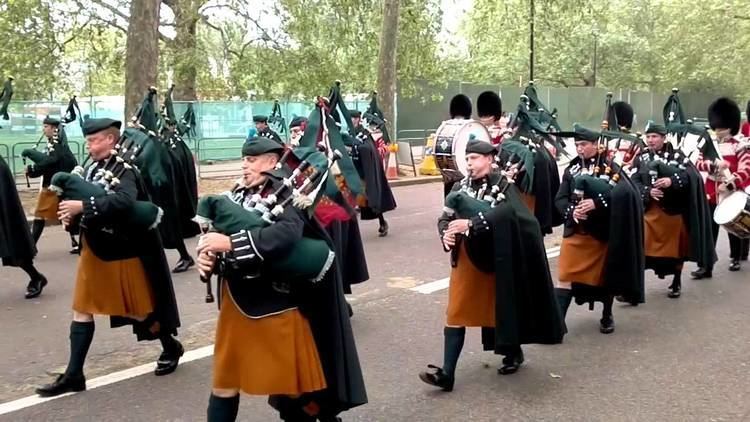
In the 1950s the Band was chosen to give the UK premier performance of Paul Hindemith's 'Symphony for Concert Band'. In 1948, the Band travelled to Palestine to support the Guards battalions involved in the troubles. Sadly, during this time the Band was ambushed and one member, Lance Corporal Ted Jones, was shot and killed. He is buried in Sarafand Military Cemetery.
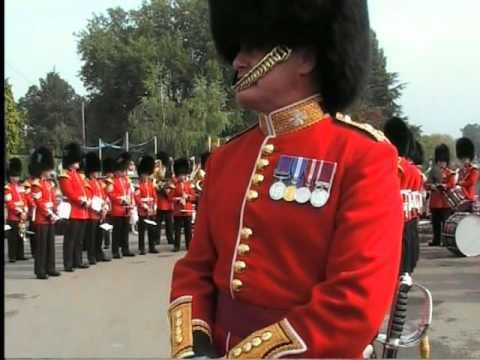
The Band has also made numerous appearances on television and in films, including The Ipcress File, and Oh! What a Lovely War, as well as being engaged to whistle 'Colonel Bogey' for the soundtrack of The Bridge on the River Kwai. A number of former Band members have continued their musical careers with national orchestras, including the Hallé, the BBC Symphony and the Royal Opera House, Covent Garden.
Two former Directors of Music, Major George Willcocks and Lieutenant Colonel 'Jiggs' Jaeger, also conducted the Black Dyke Mills Band at the National Brass Band Championships.
Over the years the Band has toured extensively, including a visit to Japan in 1972, where it was accorded the honour of being the first foreign band ever to play in the Imperial Palace in the presence of the Empress and the two Crown Princesses. Three members of the Band served in the first Gulf war in 1990/91, and in June 1999 the Band deployed to Kosovo as part of a NATO peacekeeping force.
Major Philip D. Shannon became the first Irish-born Director of Music in the regiment's history in 2008, leading the band on an eleven-week coast-to-coast tour of North America in 2010.
In 2012, the Band were privileged to be part of the Massed Bands of the Foot Guards Fanfare team, playing at the Queen's Diamond Jubilee concert in London, as well as part of the Closing Ceremony of the London 2012 Olympics.
The Band is currently based at Wellington Barracks in London and provides the musical support for all major ceremonial events in London and Windsor.
Drums and Pipes
Like the Scots Guards, the Irish Guards also boast a distinctive national feature in their pipe band. Uniquely in the British Army, the Irish Guards ensemble is referred to as the "Drums and Pipes," rather than the "Pipes and Drums." (Since drums were carried by British soldiers before pipes, the drums are senior.) They were formed during the First World War, with the first two sets of Great Irish Warpipes being donated by John Redmond, the leader of the Irish Parliamentary Party at Westminster, whose son was serving with the regiment as an officer. They were trained by the London Irish Rifles and adopted their pattern of uniform, including the practice of wearing the caubeen badge over the right eye. Unlike the regimental band, pipe bands are based at battalion level, and when additional battalions are raised for wartime service, pipe bands are also raised to accompany them. (See list of pipe majors below.)
For several decades, Irish Guards pipers carried the Great Irish Warpipes, essentially a two-drone version of the three-drone Great Highland Bagpipe. In 1968, however, with the forming of the North Irish Brigade into the Royal Irish Rangers, the Highland pipe was standardized throughout the British Army and has been used by the Irish Guards ever since.
Members of the regimental band are full-time musicians who, in the past, used to be trained for duty as medical assistants in wartime. Since the introduction of Clinical Governance regulations within the NHS, however, military musicians are deployed in a General Duties role.
Pipers and drummers have always been full-time soldiers who undertake their musical responsibilities on a part-time basis. This was underlined by the loss of two regimental pipers, Lance Corporals Ian Keith Malone and Christopher Muzvuru, during Operation Telic in Iraq. Later, in 2007, Lance Sergeant Chris Casey and Lance Corporal Kirk Redpath, both drummers in the pipe band, were killed in Iraq when their vehicle was struck by an improvised explosive device (IED).
Corps of Drums
The Corps of Drums is, in fact, a fife and drum band, under the direction of the regimental drum major. When members of the royal family are present, or at Trooping the Color or similar state occasions, the drum major wears an elaborate "state dress" uniform. Other members of the Corps of Drums wear special winged-and-laced versions of the Guards' "Home Service" dress.
WO1 George Stone, who served as drum major from 1939-41, went on to become one of the first Garrison Sergeant Majors of the London Military District, the highest ranking enlisted soldier in the London area.
Key personnel
Brigadier John mills vc recipient
Directors of Music
Lt Col mills
Pipe majors
Original title of "Sergeant Piper" was changed to "Pipe Major" via Army Order 139 of 1928, change to date from 31 July 1928. On St. Patrick's Day 1991, the Queen Mother presented the regiment with its first-ever pipe banner. This is carried by the pipe major on the bass drone of his pipes when a member of the Royal Family is present.
In 2013, Pipe Major David Rogers became the first Irish Guards piper to be appointed "Personal Piper to Her Majesty the Queen."
1st Battalion
Sergeant T. Atkins, 1917(?)-36; Sgt. F. Cosgrove, 1936–39; Colour Sgt. R.J. Batt, 1939–40; WO2 J. Smyth, 1940–43; Sgt. A.F. Phair, 1943–49; WO2 J. Ramsey, 1950–54; WO2 T.R. Ramsey, 1954–61, 1963–72; Capt. H.F. Groves, 1961–63; CSgt. W. Lyons, 1972–78; CSgt. J.M. Johnston, 1978–81; Sgt. K.J. Frazer, 1981–1991; Sgt. J. Stranix, 1991–1993; Sgt. J. Martin, 1993–95; Sgt. R. Tumulty, 1995-00; Sgt. R. Allan, 2000–05; Sgt. D. Rogers, 2005-10; Sgt. G. Loe, 2010-13; Sgt. R. Fleming, 2013-
2nd Battalion
Sgt. J.T. Crozier, 1941–44; CSgt. R.J. Batt, 1945–47;
3rd Battalion
CSgt. R.J. Batt, 1941–44; Sgt. E. Norbury, 1944–46
Training Battalion
WO2 J. Smyth, 1940; CSgt. R.J. Batt, 1940–41, 1944–45
Drum majors
Sgt. F.C James, 1900-12; Sgt. W.J Cherry, 1912-20; Sgt. G.D Smith, 1920-27; Sgt. P.H Arnsby, 1927-35; Sgt. H.G Baily, 1935-36; WOII J.J Gallagher, 1936-39; WOI G. Stone, MVO MBE, 1939-41; C/Sgt. M. Wood, 1946-51; Major V Sullivan, 1951-62; WOII K.I.E Thomas BEM, 1955-62; Sgt. H.C. Fletcher, 1962-65; Sgt. B.J Woods, 1965-66; Sgt. E.J Milligan, 1966-68; WOI M.S. Adrian, 1968-71; Sgt. M. Sullivan, 1971-73; Sgt. J.M Doughty, 1973-74; WOII C.P. Dean BEM, 1974-84; WOII R Kirkland, 1984-85; WOII J. McFarland, 1985-88; Sgt. D. Kearney, 1988-90; C/Sgt. P. Brennan, 1990-93; Sgt S. Nichols, 1994-95; WOII S. Boyd, 1996; C/Sgt. C. Alying, 1996-98; Sgt G.S. Johnston, 1998-2000; Sgt. P. Teague, 2000-?
Ensembles
There are several ensembles within the Band of the Irish Guards:
Events
The Band of the Irish Guards plays regularly at various events; it can be found in London performing at the following occasions:
The Band will be at the Edinburgh Military Tattoo this year in the month of August.
Songs
Mick's March2009
The Minstrel BoyThe Best of The Band of the Irish Guards · 2010
Let Erin Remember1995
